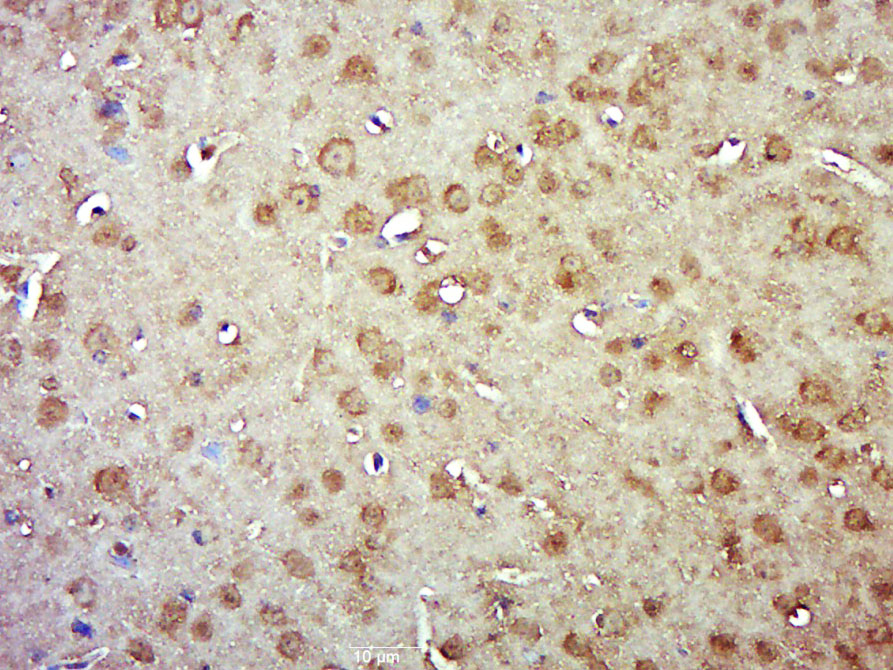SMG1 Rabbit pAb
SMG1 Rabbit pAb
- 产品详情
- 实验流程
- 背景知识
Application
| IHC-P, IHC-F, IF |
|---|---|
| Primary Accession | Q96Q15 |
| Reactivity | Rabbit, Dog |
| Host | Rabbit |
| Clonality | Polyclonal |
| Calculated MW | 410501 Da |
| Physical State | Liquid |
| Immunogen | KLH conjugated synthetic peptide derived from human SMG1 |
| Epitope Specificity | 3551-3661/3661 |
| Isotype | IgG |
| Purity | affinity purified by Protein A |
| Buffer | 0.01M TBS (pH7.4) with 1% BSA, 0.02% Proclin300 and 50% Glycerol. |
| SUBCELLULAR LOCATION | Nuclear. Cytoplasm. |
| SIMILARITY | Belongs to the PI3/PI4-kinase family. Contains 1 FAT domain. Contains 1 FATC domain. Contains 1 HEAT repeat. Contains 1 PI3K/PI4K domain. |
| SUBUNIT | Component of the SMG1C complex composed of SMG1, SMG8 and SMG9; the recruitment of SMG8 to SMG1 N-terminus induces a large conformational change in the SMG1 C-terminal head domain containing the catalytic domain. Component of the transient SURF (SMG1-UPF1-eRF1-eRF3) complex. Interacts with PRKCI. Interacts with TELO2 and TTI1. Interacts with RUVBL1 and RUVBL2. Interacts with UPF2. |
| Post-translational modifications | utophosphorylated. |
| Important Note | This product as supplied is intended for research use only, not for use in human, therapeutic or diagnostic applications. |
| Background Descriptions | This gene encodes a protein involved in nonsense-mediated mRNA decay (NMD) as part of the mRNA surveillance complex. The protein has kinase activity and is thought to function in NMD by phosphorylating the regulator of nonsense transcripts 1 protein. Alternatively spliced transcript variants have been described, but their full-length nature has yet to be determined. [provided by RefSeq, Mar 2013] |
| Gene ID | 23049 |
|---|---|
| Other Names | Serine/threonine-protein kinase SMG1, SMG-1, hSMG-1, 2.7.11.1, Lambda/iota protein kinase C-interacting protein, Lambda-interacting protein, Nonsense mediated mRNA decay-associated PI3K-related kinase SMG1 {ECO:0000312|HGNC:HGNC:30045}, SMG1 (HGNC:30045) |
| Target/Specificity | Widely expressed, with highest level in heart and skeletal muscle. Expressed in placenta, brain, lung and spleen, but not in liver. |
| Dilution | IHC-P=1:100-500,IHC-F=1:100-500,IF=1:100-500 |
| Storage | Store at -20 °C for one year. Avoid repeated freeze/thaw cycles. When reconstituted in sterile pH 7.4 0.01M PBS or diluent of antibody the antibody is stable for at least two weeks at 2-4 °C. |
| Name | SMG1 (HGNC:30045) |
|---|---|
| Function | Serine/threonine protein kinase involved in both mRNA surveillance and genotoxic stress response pathways. Recognizes the substrate consensus sequence [ST]-Q. Plays a central role in nonsense- mediated decay (NMD) of mRNAs containing premature stop codons by phosphorylating UPF1/RENT1. Recruited by release factors to stalled ribosomes together with SMG8 and SMG9 (forming the SMG1C protein kinase complex), and UPF1 to form the transient SURF (SMG1-UPF1-eRF1-eRF3) complex. In EJC-dependent NMD, the SURF complex associates with the exon junction complex (EJC) through UPF2 and allows the formation of an UPF1-UPF2-UPF3 surveillance complex which is believed to activate NMD. Also acts as a genotoxic stress-activated protein kinase that displays some functional overlap with ATM. Can phosphorylate p53/TP53 and is required for optimal p53/TP53 activation after cellular exposure to genotoxic stress. Its depletion leads to spontaneous DNA damage and increased sensitivity to ionizing radiation (IR). May activate PRKCI but not PRKCZ. |
| Cellular Location | Nucleus. Cytoplasm. Note=Present in the chromatoid body {ECO:0000250|UniProtKB:Q8BKX6} |
| Tissue Location | Widely expressed, with highest level in heart and skeletal muscle. Expressed in placenta, brain, lung and spleen, but not in liver. |
For Research Use Only. Not For Use In Diagnostic Procedures.
Provided below are standard protocols that you may find useful for product applications.
BACKGROUND
This gene encodes a protein involved in nonsense-mediated mRNA decay (NMD) as part of the mRNA surveillance complex. The protein has kinase activity and is thought to function in NMD by phosphorylating the regulator of nonsense transcripts 1 protein. Alternatively spliced transcript variants have been described, but their full-length nature has yet to be determined. [provided by RefSeq, Mar 2013]
终于等到您。ABCEPTA(百远生物)抗体产品。
点击下方“我要评价 ”按钮提交您的反馈信息,您的反馈和评价是我们最宝贵的财富之一,
我们将在1-3个工作日内处理您的反馈信息。
如有疑问,联系:0512-88856768 tech-china@abcepta.com.























 癌症的基本特征包括细胞增殖、血管生成、迁移、凋亡逃避机制和细胞永生等。找到癌症发生过程中这些通路的关键标记物和对应的抗体用于检测至关重要。
癌症的基本特征包括细胞增殖、血管生成、迁移、凋亡逃避机制和细胞永生等。找到癌症发生过程中这些通路的关键标记物和对应的抗体用于检测至关重要。 为您推荐一个泛素化位点预测神器——泛素化分析工具,可以为您的蛋白的泛素化位点作出预测和评分。
为您推荐一个泛素化位点预测神器——泛素化分析工具,可以为您的蛋白的泛素化位点作出预测和评分。 细胞自噬受体图形绘图工具为你的蛋白的细胞受体结合位点作出预测和评分,识别结合到自噬通路中的蛋白是非常重要的,便于让我们理解自噬在正常生理、病理过程中的作用,如发育、细胞分化、神经退化性疾病、压力条件下、感染和癌症。
细胞自噬受体图形绘图工具为你的蛋白的细胞受体结合位点作出预测和评分,识别结合到自噬通路中的蛋白是非常重要的,便于让我们理解自噬在正常生理、病理过程中的作用,如发育、细胞分化、神经退化性疾病、压力条件下、感染和癌症。






